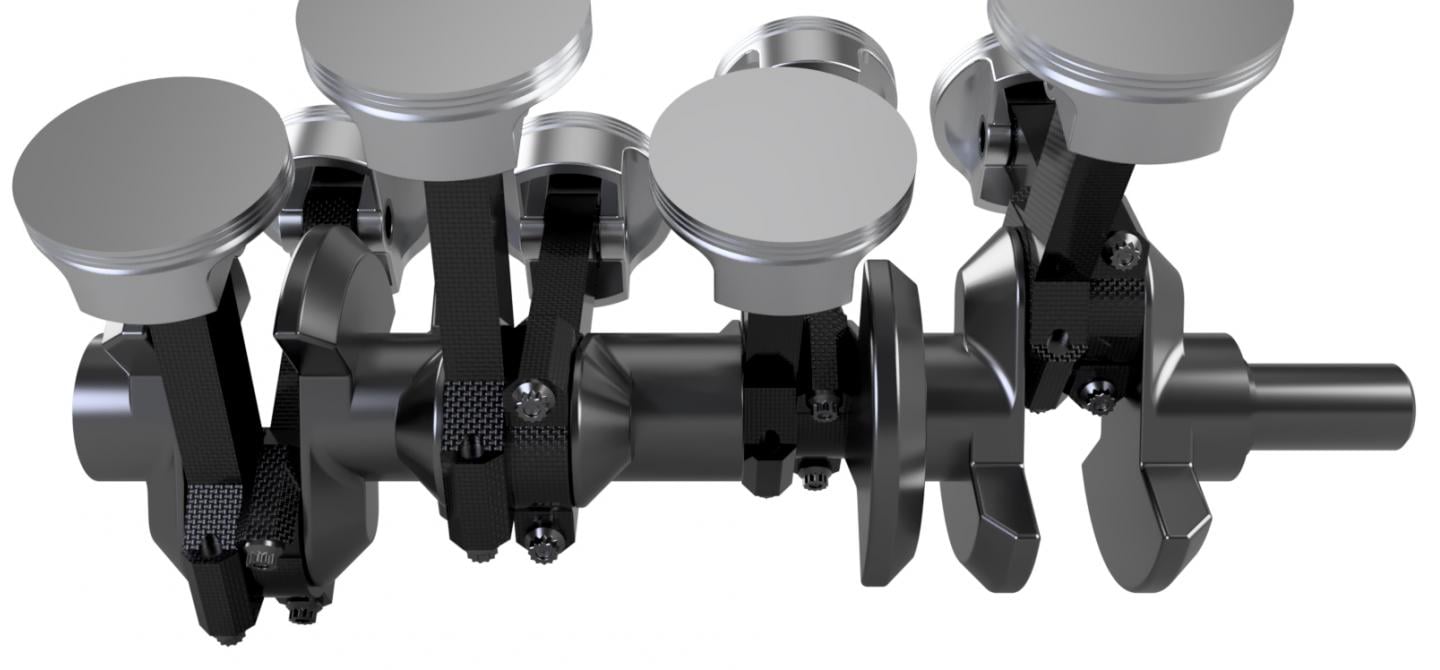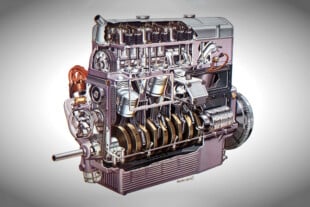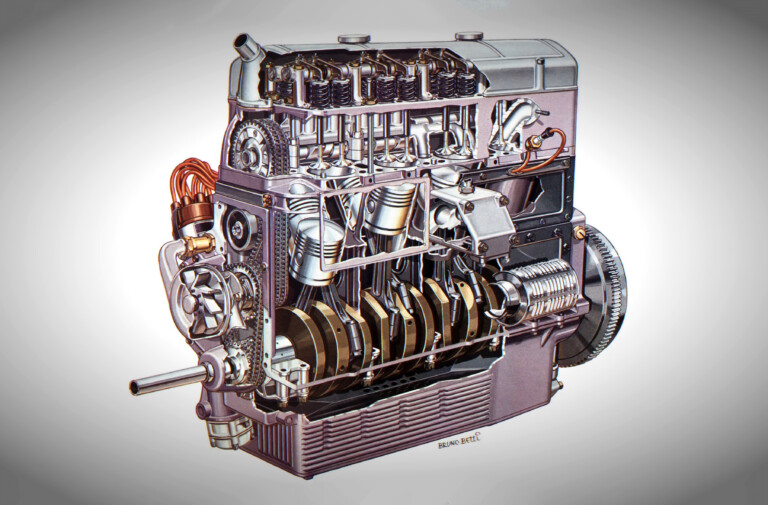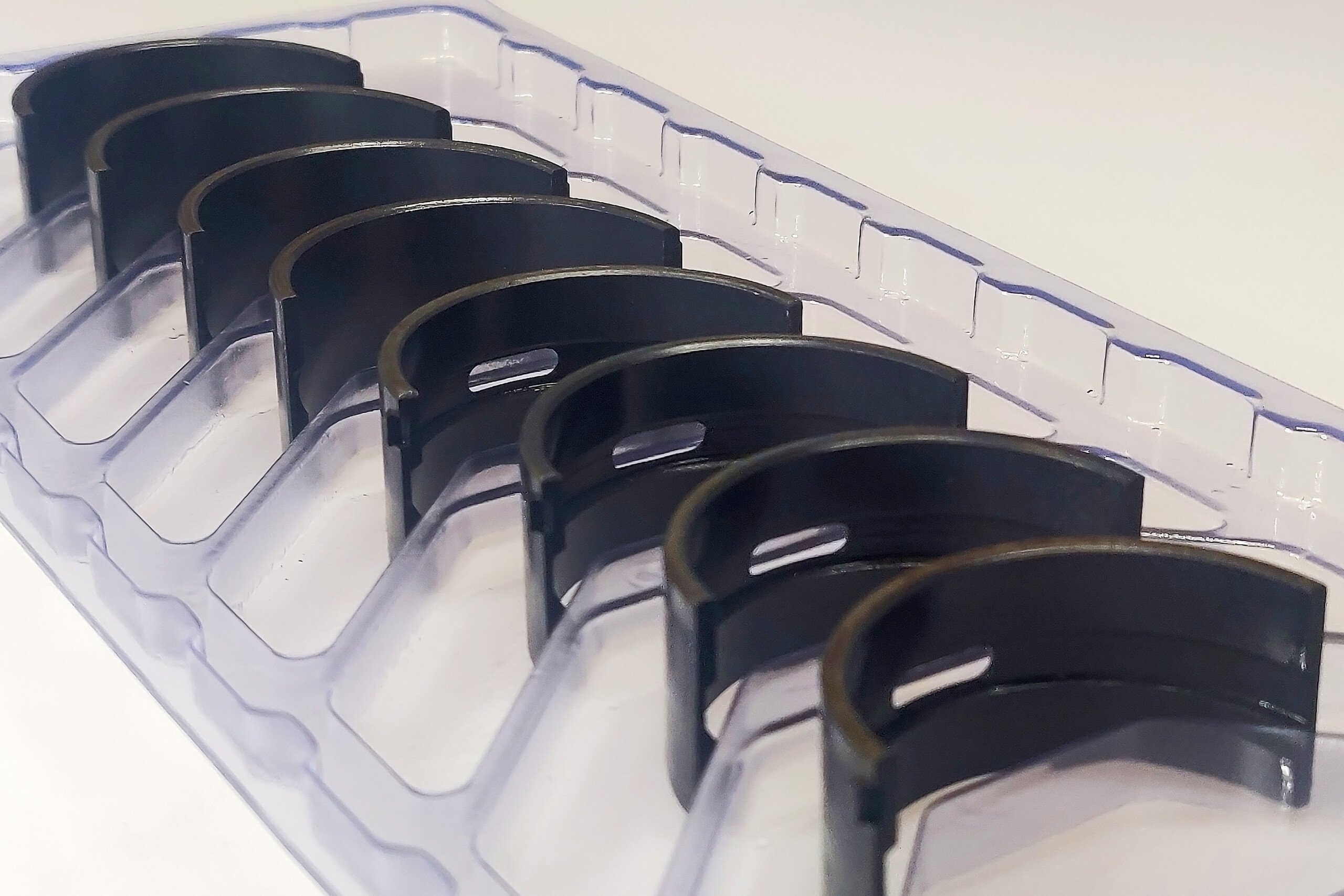The connecting rod lives a hard life. Its job is to transfer the force of combustion down the cylinder and to the crankshaft, transferring that energy into reciprocating force. All along the way, the faithful connecting rod is getting hammered and pulled to within an inch of its life.
Traditionally, internal combustion engines use a connecting rod made of steel, and sometimes in motorsports, they are made of aluminum or even titanium. Each material has its strengths and weaknesses, but, by and large, steel dominates. In the aftermarket, companies have increased the connecting rod’s strength by employing a forged steel product made of a high-grade alloy such as 4340 steel. This steel has a higher tensile strength to withstand big horsepower applications.
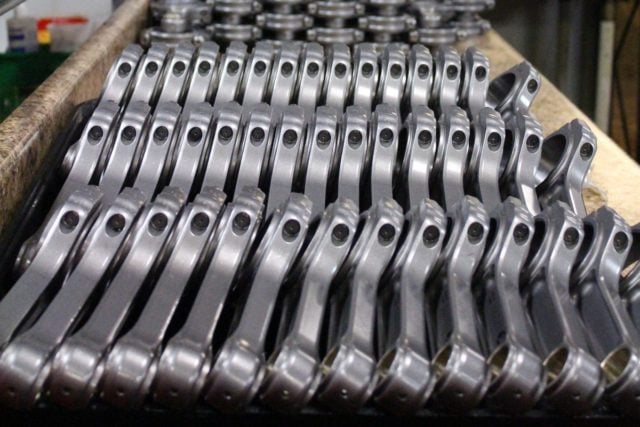
The majority of connecting rods today are made from steel or a steel alloy such as 4340. When forged, it adds strength, but still weighs more than other materials such as aluminum.
A new type of material has entered the fray in the past decade, with some significant caveats. That material is carbon fiber. When most people think of carbon fiber, they think of strength, lightness, and exotic (i.e., expensive) applications, such as in Formula One, IndyCar, or aviation. But carbon fiber has many applications today, from sports to industry, and some of its capabilities are still being unlocked.
Tastes Great, Less Filling
Carbon fiber has twice the tensile strength of steel and only half the weight of aluminum, so it is easy to see why more automotive and racing components are finding applications for this high-tech material.
To better understand how this material can be applied to internal engine parts, the YouTube channel, Driving4Answers, explains how carbon fiber is in a league of its own regarding strength.
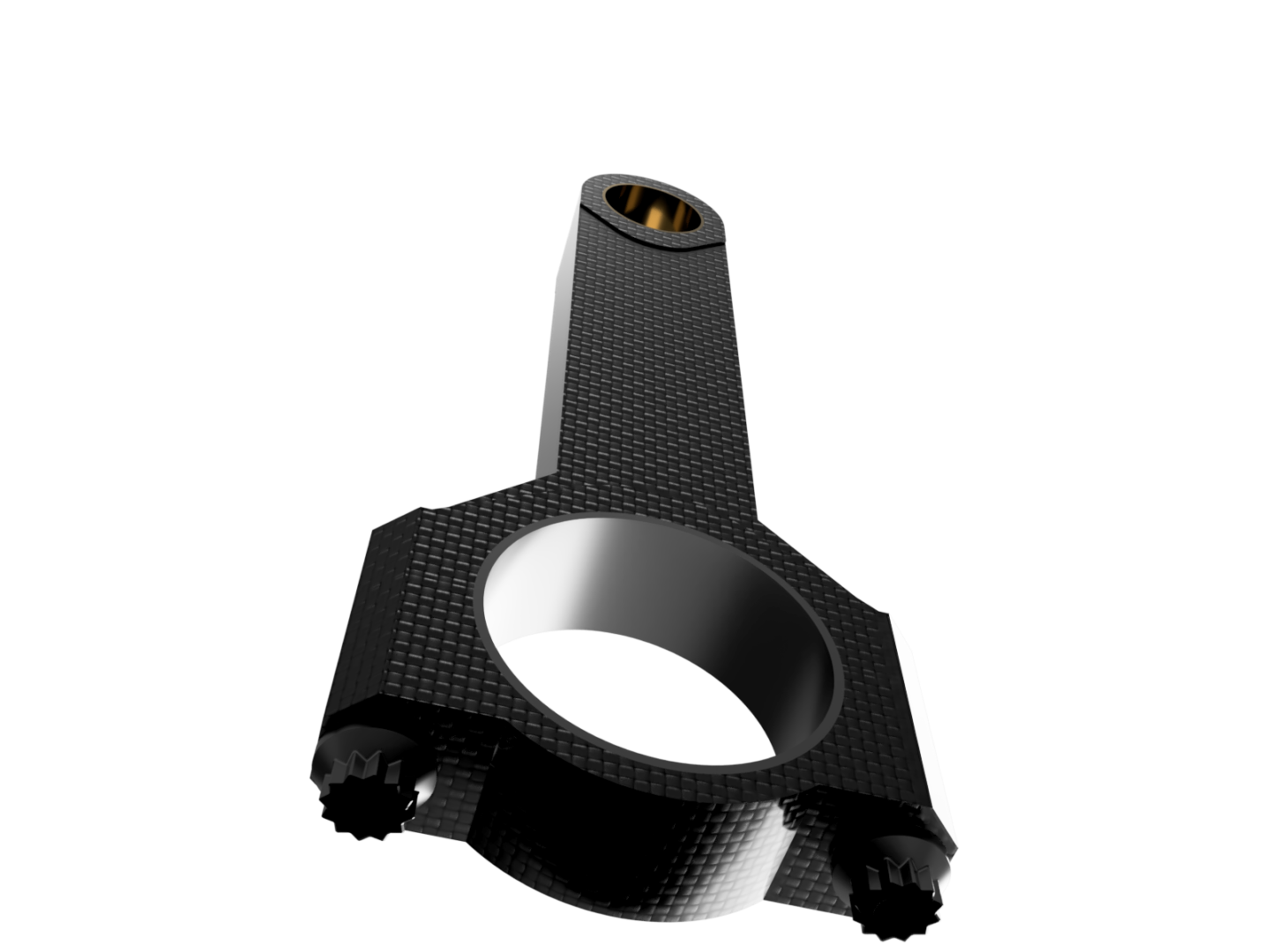
Carbon fiber has twice the tensile strength of steel and only half the weight of aluminum, which makes for an alluring mix for a connecting rod.
Aluminum isn’t as strong; D4A says that even high-grade alloys like 6061 or 7075 can only manage a maximum of 55,000 newtons per square centimeter. “Now carbon fiber is completely in a league of its own. It can survive 250,000 newtons per square centimeter before breaking.”
While carbon fiber was invented in the late 1800s, it wasn’t viable for many practical purposes until the 1970s, when different types of carbon fiber yarn began to be manufactured. These newer fibers had up to 95-percent carbon, significantly increasing their tensile strength and elasticity over earlier versions. Today, companies are now manufacturing carbon fibers with a tensile strength of 4,000 MPa (58,000 psi) and a modulus (stress rating) of 400 GPa (58,000,000 psi).
As the usage of carbon fiber increases, manufacturing costs have dropped over the years, with improved manufacturing processes being implemented. It’s still expensive compared to other materials, but with all of these improvements, engineers are beginning to understand the potential of carbon fiber in a wider variety of applications.
While there are many uses for carbon fiber outside of the engine, there’s never really been a way to use it successfully inside the engine. D4A observes how Top Fuel cars use the weakest material (aluminum) for connecting rods in engines that generate the highest loads and have the greatest chance of destroying their internals. Why? It’s all about weight. Aluminum is lighter than steel, so it helps accelerate the engine quicker off the line. But the tradeoff is that the rods will need to be replaced more frequently. With carbon fiber, however, D4A notes that it blows steel out of the water for strength and aluminum for weight.
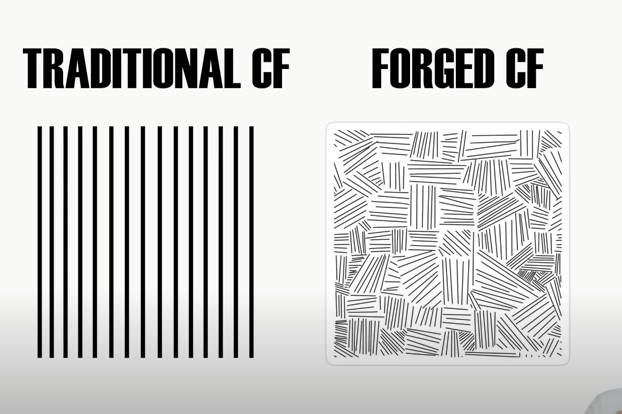
Traditional carbon fiber weave is layered in angles to create strength, but with new forging processes, a mixed ‘tow” of CF strands adds more volume and uniform strength.
Carbon fiber has no real fatigue issues and is lighter than aluminum, so it seems like a no-brainer. So why aren’t there any mass-produced carbon fiber rods? It’s strange because carbon fiber is used almost everywhere, from wheels to suspension parts. But the issue with carbon fiber, according to D4A, is that it does not exhibit isotropic properties. “When a material is isotropic, it exhibits pretty much the same mechanical and thermal properties in all its parts.”
For example, if you apply a load in a different spot of an isotropic material, it takes the same amount of force to deform or break the block. It has the same material strength everywhere. Carbon fiber isn’t isotropic; it’s orthotropic, says D4A, meaning it’s like wood. Parts made from carbon fiber are not one solid chunk, as is the case with metals. This is a big problem for engine parts
Long Chain Gang
Carbon fiber is bonded by carbon atoms that form a long chain. The fibers are stiff, strong, light, and ideal for making strong parts. Carbon fiber material comes in many shapes and sizes, including yarns, uni-directional sheets, weaves, braids, and others, which are used to create composite parts.
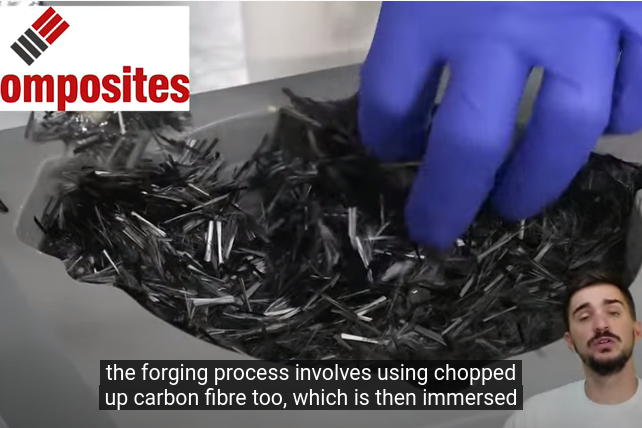
There is even a process to forge pieces of carbon fiber together, to create a unique set of properties.
The carbon fibers need a stable matrix to maintain their shape when making a part. Using epoxy resin offers compressive and shear reinforcement. Since the epoxy is low density, a component can be made that is lightweight and very strong. Many processes can be used to create these composites, including wet-layup, vacuum bagging, resin transfer, matched tooling, insert molding, and other methods. The selection of the specific resin used also allows the parts to be tailored for specific properties.
Fitting The Mold
There are limited options for forging parts out of carbon fiber, using dry carbon fiber layers, and bonding them by brushing or rolling resin onto them, or by using pre-impregnated layers. Advanced manufacturing processes involve an autoclave that exposes the part to high pressure and temperatures during the curing process. Curing helps give the part improved uniformity and surface finish. But an autoclave is expensive.

By using a compression mold, carbon fiber “tow” can fill in the form with resin and then be squeezed together slowly to impregnate all of the fibers and form the part.
The manual stacking of layers, long curing times, and the high raw material cost explain why carbon fiber parts are so expensive. Another issue is that these manufacturing processes can be very difficult to apply to parts with complex and intricate shapes.
At the Paris Motor Show in 2010, Lamborghini unveiled the Sesto Elemento, a limited production run track car. Its name means “the sixth element,” which is the atomic number of carbon. The car’s chassis, body, driveshaft, and suspension components were all made from carbon fiber. This wasn’t so unusual except that it was the first to feature a new process of forging composites. It was a new process that created much greater strength and was used in the tub and suspension arms of the car. But they also claimed to be forging carbon fiber connecting rods for the actual production run of the vehicle. The latter never came to pass.

Lamborghini’s all-carbon model, Sesto Elemento was a limited production track car with the concept of using forged carbon fiber connecting rods.
Pump Up The Volume
Forged carbon fiber composite contains a higher volume of fiber content, which, combined with higher variation in strand orientation, increases the average strength and reduces variability over standard carbon fiber layers. The material is about one-third the density of titanium and has equal or greater strength. It is made from chopped carbon fiber tows immersed in a resin film that is formed and cured.
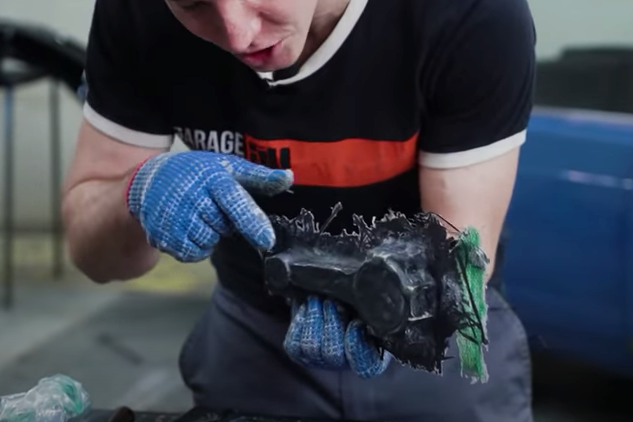
Using a more traditional vacuum bagging method and layered carbon fiber sheets, Garage 54 attempts to make a couple of connecting rods for their Russian-built Lada four-cylinder. Watch the video to see how it works out.
With forged carbon fiber, there are about 500,000 intertwined fibers per square inch. The fibers contain intertwined and folded sheets of carbon aligned with the length of the fiber, and interweaving them improves the fiber’s strength. The result is improved load carrying capacity measured in bending per unit of mass. Because of its chopped nature, it can be molded more easily into complex geometries than traditional carbon fiber can be. This enables three-dimensional parts to be made that feature intricate details such as thickness transitions, holes, compound curvature, and so on.
While the carbon composite forging process seems to work well for intricate and complex part shapes, using them in a high-heat environment such as an engine block poses more challenges regarding the type of resin required.
According to one composite manufacturer, using high-performance resins have some drawbacks. Not only do they cost more to produce, but the resins are also not quite ready for prime time, from what we understand. This may be why we haven’t seen mass-produced carbon fiber connecting rods in the aftermarket.
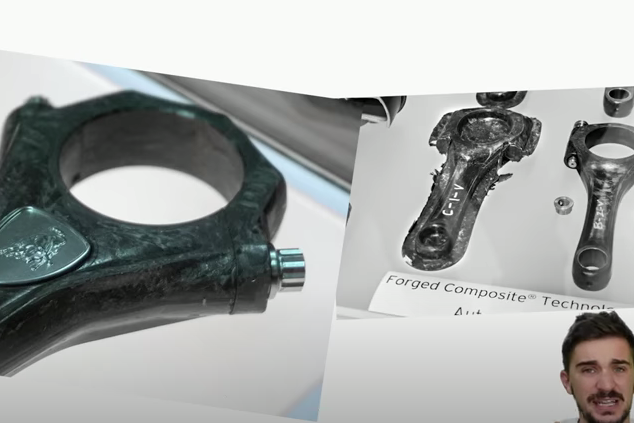
Lamborghini’s prototype forged carbon fiber components are cured using vinyl ester as the matrix resin. The rods only weigh 203.5 grams versus 457.75 grams for similar rods made from steel.
“Most common carbon fibers use an epoxy resin, and in terms of handling heat, there is what’s known as a glass transition temperature,” Chris Naimo explained to LSX Magazine in 2017. At the time, he was planning to manufacture carbon fiber connecting rods for LS engines. “At room temperature, the epoxy resin is very strong, but as you begin to raise the temperature, it loses strength, and if you were to chart it out — strength versus temperature — as the temperature increases, it would start to curve down and settle out low and become a horizontal line. That range, where it decreases in strength, is known as the ‘glass transition temperature.'”
Additives can be used to transform the epoxy resin for high heat applications, according to Naimo. But he says it’s also a function of the curing process. And when this process is performed at a higher temperature over a more extended period, it also increases the glass transition temperature.
At least one manufacturer is known to be working on carbon fiber connecting rods for use in a Top Fuel car, and they have tested them successfully. This company is also developing carbon fiber pistons. As for mass-produced carbon fiber connecting rods for your hot rod, that may be a while. Lamborghini still hasn’t produced a carbon fiber connecting rod for the Aventador, as the last V-12s are rolling across the assembly line.


